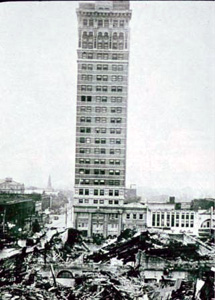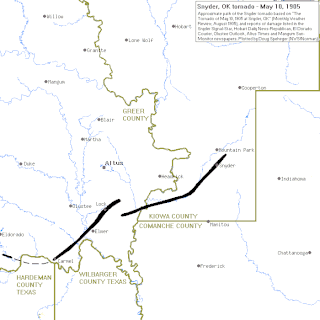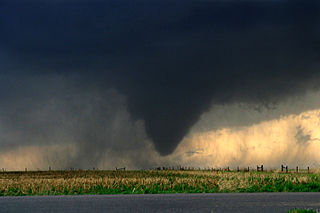The Great Natchez tornado hit Natchez, Mississippi, on Thursday, May 7, 1840. The tornado was the second-deadliest tornado in United States history; at least 317 people were killed and at least 109 were injured. While officially unrated, it is retrospectively estimated to have been an extremely violent F5 tornado on the Fujita scale. Its 35-mile-long (56 km), 1,000-yard-wide path was marked by severe damage and uncertain estimates of casualties, though many enslaved Africans—possibly numbering in the hundreds—reportedly died on plantations in Louisiana.
On April 5–6, 1936, an outbreak of 14 tornadoes struck the Southeastern United States, killing at least 454 people and injuring at least 2,500 others. Over 200 people died in Georgia alone, making it the deadliest disaster ever recorded in the state.
The 1947 Glazier–Higgins–Woodward tornadoes were a series of related tornadoes spawned by a single supercell that swept through the U.S. states of Texas, Oklahoma, and Kansas on Wednesday, April 9, 1947. Most of the damage and all the deaths are still blamed on one large F5 tornado, known as the Glazier–Higgins–Woodward Tornado, that traveled nearly 125 miles from Texas to Oklahoma. This event was often compared to the Tri-State Tornado, because it was originally thought to have left a 219-mile path, but it is now believed to have been part of a family of eight or nine tornadoes.

The 1985 United States–Canada tornado outbreak, referred to as the Barrie tornado outbreak in Canada, was a major tornado outbreak that occurred in Ohio, Pennsylvania, New York, and Ontario, on May 31, 1985. In all 44 tornadoes were counted including 14 in Ontario, Canada. It is the largest and most intense tornado outbreak ever to hit this region, and the worst tornado outbreak in Pennsylvania history in terms of deaths and destruction.

A deadly series of at least 33 tornadoes hit at least 10 different U.S. states on May 9–11, 1953. Tornadoes appeared daily from Minnesota in the north to Texas in the south. The strongest and deadliest tornado was a powerful F5 tornado that struck Waco, Texas on May 11, causing 114 of the 144 deaths in the outbreak. Alongside the 1902 Goliad tornado, it was the deadliest tornado in Texas history and is the 11th deadliest tornado in U.S. history. The tornado's winds demolished more than 600 houses, 1,000 other structures, and over 2,000 vehicles. 597 injuries occurred, and many survivors had to wait more than 14 hours for rescue. The destruction dispelled a myth that the geography of the region spared Waco from tornadoes, and along with other deadly tornadoes in 1953, the Waco disaster was a catalyst for advances in understanding the link between tornadoes and radar-detected hook echoes. It also generated support for improved civil defense systems, the formation of weather radar networks, and improved communications between stakeholders such as meteorologists, local officials, and the public.

The tornado outbreak of April 6–9, 1998 was a large tornado outbreak that started on April 6 across the Great Plains and ended on April 9 across the Carolinas and Georgia. A total of 62 tornadoes touched down from the Middle Atlantic States to the Midwestern United States and Texas. The outbreak is infamous for producing a deadly F5 that tore through the suburbs of Birmingham, Alabama, killing 32 people. The Birmingham tornado was one of only two F5 tornadoes that year. The other hit in Lawrence County, Tennessee, on April 16, as part of the same outbreak as the Nashville F3 tornado. This tornado outbreak was responsible for 41 deaths: 7 in Georgia and 34 in Alabama.

Central Minnesota is the central part of the state of Minnesota. No definitive boundaries of the region exist, but most definitions would include the land north of Interstate 94, east of U.S. Highway 59, south of U.S. Highway 2, and west of U.S. Highway 169.

From April 2–3, 1956, a large, deadly tornado outbreak affected the Great Plains, parts of the South, and the upper Midwest in the contiguous United States. The outbreak produced 47 tornadoes, including an F5 tornado that devastated the Hudsonville and Standale areas in the U.S. state of Michigan on April 3. It was one of three tornadoes to move across southwest Lower Michigan on that day. A fourth tornado struck north of the Manistee area. The Hudsonville-Standale tornado killed 17 and injured 292. These tornadoes were part of a tornado outbreak that took place on April 2–3, 1956, across the U.S. Midwest and the Great Lakes regions. In addition to the fatalities in Kansas, Oklahoma, Michigan and Berlin, Wisconsin, three people were killed in Tennessee, one person in Kentucky and two more people in Wisconsin. In total, 38 were killed during the entire event.

On the evening of June 20, 1957, a violent and deadly F5 tornado struck the north side and downtown area of Fargo, North Dakota as well as the area north of Moorhead, Minnesota. It was part of a family of five devastating tornadoes produced by one supercell over the course of 3.5 hours, although they are listed as one continuous tornado. The tornado family started in North Dakota, traveled 27.4 miles (44.1 km) to the Minnesota border before crossing it and continuing for another 25 miles (40 km) for a total track length of 52.4 miles (84.3 km). Additionally, at its widest point, the damage swath reached 500 yards (460 m) across. A total of 10 people were killed, making it the deadliest tornado in North Dakota history. Meanwhile, 103 others were injured, and damage was estimated at $25.25 million. It was part of a larger outbreak sequence of 23 tornadoes that affected the Midwest and Great Plains.

Minnesota has a humid continental climate, with hot summers and cold winters. Minnesota's location in the Upper Midwest allows it to experience some of the widest variety of weather in the United States, with each of the four seasons having its own distinct characteristics. The area near Lake Superior in the Minnesota Arrowhead region experiences weather unique from the rest of the state. The moderating effect of Lake Superior keeps the surrounding area relatively cooler in the summer and warmer in the winter, giving that region a smaller yearly temperature variation. On the Köppen climate classification, much of the southern third of Minnesota—roughly from the Twin Cities region southward—falls in the hot summer zone (Dfa), and the northern two-thirds of Minnesota falls in the warm summer zone (Dfb).

The 1905 Snyder, Oklahoma, tornado was a powerful tornado that struck the town of Snyder, Oklahoma, in Kiowa County on Wednesday, May 10, 1905. The event was one of the worst natural disasters ever to hit the state of Oklahoma. The cyclone killed 97 people, making it the second most deadly tornado in Oklahoma history. The tornado was part of a larger, multiple-day tornado outbreak that hit several states across the Midwestern United States, including Kansas, Oklahoma, and Missouri.

On April 14–15, 1886, a destructive tornado outbreak affected portions of the Midwestern and Southern United States. The outbreak generated at least 18 tornadoes, four of which were violent, including the St. Cloud–Sauk Rapids tornado, an F4 tornado that tore through the cities of St. Cloud, Sauk Rapids, and Rice, Minnesota, on April 14, destroying much of the town of Sauk Rapids and killing 72 people along its path. It is the deadliest tornado on record in Minnesota. Other tornadoes occurred in Iowa, Kansas, Missouri, and Texas on the same day, suggesting the possibility of a large outbreak. In all, the entire outbreak killed at least 87 people and injured at least 324.

The Tornado outbreak of May 1968 was a significant and deadly tornado outbreak that struck most of the central and southern United States from May 15 to May 16, 1968. Producing 46 tornadoes, the outbreak killed at least 72 people, including 45 in Arkansas alone. The outbreak also produced two F5 tornadoes in Iowa. It was one of the deadliest tornado outbreaks in the United States since the 1960s and is one of the deadliest outbreaks in Iowa history.
The 1956 McDonald Chapel tornado was a deadly weather event that took place during the afternoon of April 15, 1956, across the Greater Birmingham area in Jefferson County, Alabama, with damage most severe in McDonald Chapel. The F4 tornado killed 25 people and injured 200 others. While only two known tornadoes touched down across the Southeastern United States on that day, the Birmingham tornado produced major devastation across areas west and north of downtown Birmingham.
On June 3–4, 1958, a destructive tornado outbreak affected the Upper Midwestern United States. It was the deadliest tornado outbreak in the U.S. state of Wisconsin since records began in 1950. The outbreak, which initiated in Central Minnesota, killed at least 28 people, all of whom perished in Northwestern Wisconsin. The outbreak generated a long-lived tornado family that produced four intense tornadoes across the Eau Claire–Chippewa Falls metropolitan area, primarily along and near the Chippewa and Eau Claire rivers. The deadliest tornado of the outbreak was a destructive F5 that killed 21 people and injured 110 others in and near Colfax, Wisconsin.

The tornado outbreak sequence of May 1896 was a series of violent and deadly tornado outbreaks that struck much of the Central and Southern United States from May 15 to 28, 1896. It is considered one of the worst tornado outbreak sequences on record with tornado expert Tom Grazulis stating that the week of May 24–28 was "perhaps the most violent single week of tornado activity in United States history". There were four particularly notable tornado outbreaks during the two-week period. It produced three F5 tornadoes as well as the third deadliest tornado ever in United States history. A total of 484 people were killed during the entire outbreak sequence by at least 38 different tornadoes which struck Texas, Oklahoma, Kansas, Nebraska, Kentucky, Iowa, Illinois, Michigan, Missouri, Pennsylvania, New Jersey and Maryland.

A multi-day tornado outbreak affected the central plains of the United States from May 22–27, 2008. It was also one of the largest continuous tornado outbreaks on record. A total of 173 tornadoes were confirmed, with the most intense activity occurring across the Great Plains. One person was killed when a large wedge tornado struck Windsor, Colorado, and two more deaths were reported in Pratt County, Kansas. One person was also killed near Hugo, Minnesota on May 25 and nine were killed by an EF5 tornado that destroyed most of Parkersburg, Iowa and a small subdivision of New Hartford, Iowa. Another fatality, caused by lightning related to the storms, occurred in central Kansas.

The 2011 Super Outbreak was the largest, costliest, and one of the deadliest tornado outbreaks ever recorded, taking place in the Southern, Midwestern, and Northeastern United States from April 25 to 28, 2011, leaving catastrophic destruction in its wake. Over 175 tornadoes struck Alabama, Mississippi, and Tennessee, which were the most severely damaged states. Other destructive tornadoes occurred in Arkansas, Georgia, Kentucky, Louisiana, New York, and Virginia, with storms also affecting other states in the Southern and Eastern United States. In total, 360 tornadoes were confirmed by NOAA's National Weather Service (NWS) and Government of Canada's Environment Canada in 21 states from Texas to New York to southern Canada. Widespread and destructive tornadoes occurred on each day of the outbreak. April 27 was the most active day, with a record 216 tornadoes touching down that day from midnight to midnight CDT. Four of the tornadoes were rated EF5, which is the highest ranking on the Enhanced Fujita scale; typically these tornadoes are recorded no more than once a year.

A deadly and destructive outbreak sequence of 23 tornadoes struck parts of the Great Plains and the Great Lakes in late-June 1957. At least seven significant tornadoes (F2+) touched down during the outbreak sequence. The most devastating storm was a large, violent, and catastrophic 500-yard-wide F5 tornado family that struck Fargo, North Dakota on Thursday, June 20, 1957, killing 10 people and becoming the deadliest tornado ever recorded in North Dakota. The outbreak caused 11 fatalities, 105 injuries, and $25.883 million in damage.

This page documents the tornadoes and tornado outbreaks of 1947, primarily in the United States. Most recorded tornadoes form in the U.S., although some events may take place internationally. Tornado statistics for older years like this often appear significantly lower than modern years due to fewer reports or confirmed tornadoes.
















